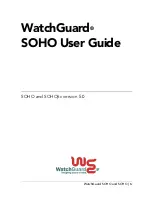
ZyWALL ATP Series User’s Guide
496
C
HAPTER
26
Application Patrol
26.1 Overview
Application patrol provides a convenient way to manage the use of various applications on the
network. It manages general protocols (for example, HTTP and FTP) and instant messenger (IM), peer-to-
peer (P2P), Voice over IP (VoIP), and streaming (RSTP) applications. You can even control the use of a
particular application’s individual features (like text messaging, voice, video conferencing, and file
transfers).
26.1.1 What You Can Do in this Chapter
• Use the
App Patrol
summary screen (see
) to manage the application patrol
profiles. You can also view license registration and signature information.
• Use the
App Patrol Add/Edit
screens (see
set actions for application categories and for specific applications within the category.
26.1.2 What You Need to Know
If you want to use a service, make sure both the Security Policy and application patrol allow the
service’s packets to go through the Zyxel Device.
Note: The Zyxel Device checks secure policies before it checks application patrol rules for
traffic going through the Zyxel Device.
Application patrol examines every TCP and UDP connection passing through the Zyxel Device and
identifies what application is using the connection. Then, you can specify whether or not the Zyxel
Device continues to route the connection. Traffic not recognized by the application patrol signatures is
ignored.
Application Profiles & Policies
An application patrol profile is a group of categories of application patrol signatures. For each profile,
you can specify the default action the Zyxel Device takes once a packet matches a signature (forward,
drop, or reject a service’s connections and/or create a log alert).
Use policies to link profiles to traffic flows based on criteria such as source zone, destination zone, source
address, destination address, schedule, user.
Classification of Applications
There are two ways the Zyxel Device can identify the application. The first is called auto. The Zyxel
Device looks at the IP payload (OSI level-7 inspection) and attempts to match it with known patterns for
specific applications. Usually, this occurs at the beginning of a connection, when the payload is more
consistent across connections, and the Zyxel Device examines several packets to make sure the match
Содержание ATP200
Страница 23: ...23 PART I User s Guide ...
Страница 113: ...113 PART II Technical Reference ...
Страница 216: ...Chapter 9 Interfaces ZyWALL ATP Series User s Guide 216 Configuration Network Interface Ethernet Edit External Type ...
Страница 218: ...Chapter 9 Interfaces ZyWALL ATP Series User s Guide 218 Figure 170 Configuration Network Interface Ethernet Edit OPT ...
Страница 236: ...Chapter 9 Interfaces ZyWALL ATP Series User s Guide 236 Figure 179 Configuration Network Interface PPP Add ...
Страница 244: ...Chapter 9 Interfaces ZyWALL ATP Series User s Guide 244 Figure 181 Configuration Network Interface Cellular Add Edit ...
Страница 259: ...Chapter 9 Interfaces ZyWALL ATP Series User s Guide 259 Figure 191 Configuration Network Interface VLAN Add Edit ...
Страница 260: ...Chapter 9 Interfaces ZyWALL ATP Series User s Guide 260 ...
Страница 273: ...Chapter 9 Interfaces ZyWALL ATP Series User s Guide 273 Figure 193 Configuration Network Interface Bridge Add Edit ...
Страница 361: ...Chapter 15 UPnP ZyWALL ATP Series User s Guide 361 Figure 250 Network Connections My Network Places Properties Example ...
Страница 387: ...Chapter 20 IPSec VPN ZyWALL ATP Series User s Guide 387 Figure 271 Configuration VPN IPSec VPN VPN Connection Add Edit ...
Страница 395: ...Chapter 20 IPSec VPN ZyWALL ATP Series User s Guide 395 Figure 273 Configuration VPN IPSec VPN VPN Gateway Add Edit ...
Страница 478: ...Chapter 25 Security Policy ZyWALL ATP Series User s Guide 478 Figure 328 Configuration Security Policy Policy Control ...
Страница 712: ...Chapter 37 System ZyWALL ATP Series User s Guide 712 Figure 470 Configuration System WWW Login Page Desktop View ...
















































